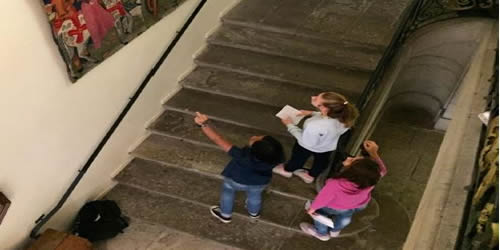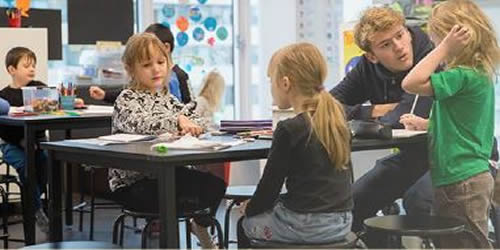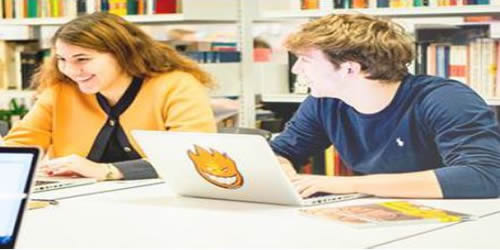
In this treasure hunt project, students are invited to interact in modern languages in different places of the school and with different actors.
Cité scolaire Lucie Aubrac, Courbevoie, académie de Versailles, France

Intercultural and cross subject project team
Collège Henri Matisse, Linselles, académie de Lille, France

Interdisciplinary project German and arts
Collège de l’Esplanade, Strasbourg, académie de Strasbourg, France

Students created an augmented reality animation on tablets for other classes.
Collège Jean Moulin, Berck sur Mer, académie de Lille, France

Team teaching modern languages and sports: students discover part of the written instructions in a foreign language.
Collège Henri Matisse, Lille, académie de Lille, France

Team teaching modern languages and sports: students discover part of the written instructions in a foreign language.
Collège Henri Matisse, Lille, académie de Lille, France

Eurolangues project: every week pupils practice German, English and Spanish at the same time around European cultural facts and thus develop negotiating and mediation skills.
Lycée Victor et Hélène Basch, Rennes, académie de Rennes, France

Using all learning spaces: during the day of Europe the students transformed the stairs into a map of Europe.
Lycée Evariste Galois, Sartrouville, académie de Versailles, France

Food health education in Spanish class
Collège Jean Moulin, Lille, académie de Lille, France

Cooking session in English in Ader Hotel school with students from Fresnel school
Lycée hôtelier Ader et lycée général Fresnel, Bernay, académie de Rouen, France

Intercultural exhibition – return from school trip
Lycée Lumière, Luxeuil les Bains, académie de Besançon, France

Walk and talk: students guide tourists
Collège André Chénier, Carcassonne, académie de Montpellier, France

Mother Earth brings help to teach written English
English lesson in South Soudan, GB

Multilingual Flashmob: students use their multilingual skills to perform spontaneous choreography.
Lycée Henri Avril, Lamballe, académie de Rennes, France

Active participation of students around playful activities. Motivation is the key, also to pass certifications in languages (here the A1 Delf in Norway)
Haugenstua skole, Oslo, Norway

Active participation of students around playful activities. Motivation is the key, also to pass certifications in languages (here the A1 Delf in Norway)
Haugenstua skole, Oslo, Norway

Active participation of students around playful activities. Motivation is the key, also to pass certifications in languages (here the A1 Delf in Norway)
Haugenstua skole, Oslo, Norway

Introducing through a song, simple words and short sentences to the personal preferences on the theme of nutrition
First year of French, Cyprus

Language classrooms are the place to express values, share messages and communicate with students. Walls can be used for a long-term communication, for example by proverbs, quotes or phrases of encouragement.
Primary school, Montenegro

Language classrooms are the place to express values, share messages and communicate with students. Walls can be used for a long-term communication, for example by proverbs, quotes or phrases of encouragement.
Primary school, Montenegro

Students create a silhouette and thereby make their multilingualism visible. Two years later, the students get the product back: they want to explain what has changed in recent years with regard to multilingualism (didactics) as well as attitude and attitude towards multilingualism.
Pädagogische Hochschule St. Gallen, Switzerland

2nd graders learning English in a state primary school in Greece. They have created masks which they will use as class mascots throughout the year. In this lesson they are using the masks to introduce themselves.
Primary school, Greece

Brunch between the students of the Ader high school and those of the Fresnel high school in Bernay
Lycée professionnel Ader, Bernay, académie de Rouen, France

More motion in each subject according the new folkeskole reform.
Primary school, Denmark

Learning together in small groups (‘læsegruppe’), an approach initiated at any age
Primary school, Denmark

Learning together in small groups (‘læsegruppe’), an approach initiated at any age
Upper-secondary school, Denmark

Learning together in small groups (‘læsegruppe’), an approach initiated at any age
Aarhus University, Denmark

The new building where the future teachers in the primary school are educated
VIA University College in Aarhus, Denmark

The new building where the future teachers in the primary school are educated
VIA University College in Aarhus, Denmark

A group of B2 students from the Alliance Française in Durrës plan to continue their studies abroad and prepare the DELF / DALF together.
Dürres, Albania

We organised a language week in our school where all languages (german, french, spanish, italian as well as Maltese the national language and English the second language) taught came together. We organised also a platter with food from each country and this board was put up. Here we included greetings in all the languages, together with the flag and map of each country
Secondary school, Malta

Classroom settings say a lot about the pedagogical approach. When tables are arranged in circle it allows much more interaction than regular bus seat rows. Using various organisations in the classroom (stations, rows, individual tables, etc.) and various spaces at the school or faculty (library, sciences lab, open spaces, etc.) lead to a flexible learning environment.
Faculty of Brno, Czechia

Classroom settings say a lot about the pedagogical approach. When tables are arranged in circle it allows much more interaction than regular bus seat rows. Using various organisations in the classroom (stations, rows, individual tables, etc.) and various spaces at the school or faculty (library, sciences lab, open spaces, etc.) lead to a flexible learning environment.
Faculty of Brno, Czechia

Immersion in the target language. Different Russian national dresses and other things form the cultural background here.
Classroom for Russian language in Lithuania, Lithuania

Immersion in the target language. Different Russian national dresses and other things form the cultural background here.
Classroom for Russian language in Lithuania, Lithuania

Seating arrangement for a language-friendly environment in the classroom. The students always sit in groups and in a circle.
Classroom for German language in Lithuania, Lithuania

Presentation and work of a student as a supplement to the topic of sports
Classroom for German language in Lithuania, Lithuania

All teachers are language teachers. Developing CLIL contributes to both student education and teacher professional development.
CLIL PE lesson, Netherlands

Language showering project: how pre school age Finnish children learn Swedish language.
Teaching material, Finland

Language showering project: how pre school age Finnish children learn Swedish language.
Teaching material, Finland

Fluent speakers of Russian trying out handwritten Russian for the first time. Russian is one of a number of languages being supported in the Home-in-Language club at Maynooth Post Primary School.
Home in language club Maynooth post primary school, Ireland

Speaking walls – Involving learners in the classroom design is one of the best way to set up a learner friendly environment and the first step towards communication skills.
Erasmus Plus project about food in UK and Italy, Latvia

Speaking walls – Involving learners in the classroom design is one of the best way to set up a learner friendly environment and the first step towards communication skills.
Work in groups lesson clothes and cloth, Latvia

Speaking walls – Involving learners in the classroom design is one of the best way to set up a learner friendly environment and the first step towards communication skills.
Work in groups lesson clothes and cloth, Latvia